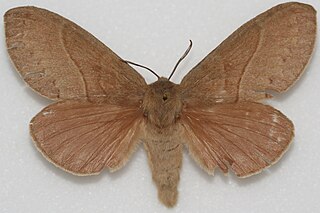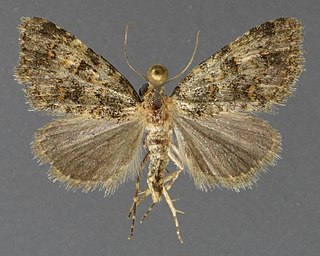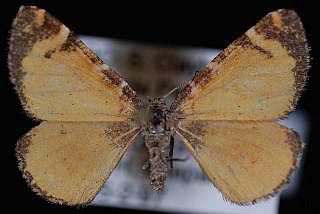
Idia is a genus of litter moths of the family Erebidae first described by Jacob Hübner in 1813.

Renia is a genus of litter moths of the family Erebidae erected by Achille Guenée in 1854.

Grotella is a genus of moths of the family Noctuidae first described by Leon F. Harvey in 1875.

Dasychira is a genus of tussock moths in the family Erebidae described by Jacob Hübner in 1809. They are well distributed all over Africa, Europe, North America, Madagascar, Japan, China, India, Sri Lanka, Myanmar, Java and Australia.

Dicogaster is a genus of moths in the family Lasiocampidae first described by William Barnes and James Halliday McDunnough in 1911. Its only species, Dicogaster coronada, was first described by Barnes in 1904. It is found in Arizona.
Hymenodria is a monotypic moth genus in the family Geometridae erected by James Halliday McDunnough in 1954. Its only species, Hymenodria mediodentata, was first described by William Barnes and McDunnough in 1911. It is found in North America.

Grotella citronella is a species of moth in the genus Grotella, of the family Noctuidae. This moth is found in North America, including the Mojave Desert region of California. This species was first described by William Barnes and James Halliday McDunnough in 1916.

Cryphia nana is a moth of the family Noctuidae first described by William Barnes and James Halliday McDunnough in 1911. It can be found in the US state of California.
Schinia aetheria is a moth of the family Noctuidae first described by William Barnes and James Halliday McDunnough in 1912. It is found in North America, including Arizona, Nevada, New Mexico and Utah.
Idia parvulalis is a species of litter moth of the family Erebidae first described by William Barnes and James Halliday McDunnough in 1911. It is found in North America, including its type location, the Santa Catalina Mountains in south-eastern Arizona.
Renia nemoralis, the tardy renia or chocolate renia moth, is a litter moth of the family Erebidae. It is found in the US from Illinois to south-eastern Massachusetts south to Florida and Texas. The species was first described by William Barnes and James Halliday McDunnough in 1918.
Ursia is a genus of moths of the family Notodontidae, the prominents. The genus was erected by William Barnes and James Halliday McDunnough in 1911.
Acroncosa is a genus of snout moths in the subfamily Phycitinae. It was described by William Barnes and James Halliday McDunnough in 1917. The type species is Acroncosa albiflavella.
Anemosella viridalis is a species of snout moth in the genus Anemosella. It was described by William Barnes and James Halliday McDunnough in 1912, and is known from Mexico and the US state of Arizona.
Agylla septentrionalis is a moth of the family Erebidae. It was described by William Barnes and James Halliday McDunnough in 1911. It is found in North America, including Arizona and South Carolina.
Lycomorpha splendens is a moth of the family Erebidae. It was described by William Barnes and James Halliday McDunnough in 1912. It is found in North America, including Arizona, California, Nevada, New Mexico, Texas and Utah.
Cisthene subrufa, the Tamaulipan lichen moth, is a moth of the family Erebidae. It was described by William Barnes and James Halliday McDunnough in 1913. It is found in the United States in Arizona and from San Benito, Texas south to Veracruz in Mexico.
Hellula aqualis is a moth in the family Crambidae. It was described by William Barnes and James Halliday McDunnough in 1914. It is found in North America, where it has been recorded from Arizona, California, Colorado, Nevada, New Mexico and Texas.
Sericosema immaculata is a moth in the family Geometridae described by William Barnes and James Halliday McDunnough in 1913. It is found in North America.

Stamnodes topazata is a species of geometrid moth in the family Geometridae. It is found in North America.
This page is based on this
Wikipedia article Text is available under the
CC BY-SA 4.0 license; additional terms may apply.
Images, videos and audio are available under their respective licenses.







